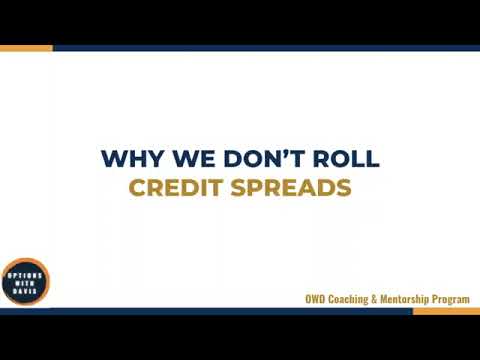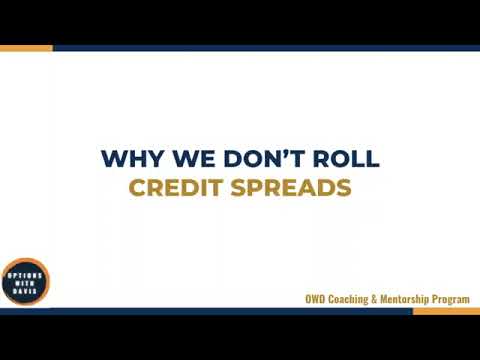In the video titled “3-17 Why We Don’t Roll Credit Spreads” by Find a Service NOW, the speaker discusses the reasons why rolling credit spreads is generally not recommended. The only time rolling is considered is when the short strikes in the iron condor are tested. However, with credit spreads, there is no untested side to roll to, making it a riskier option. Rolling a credit spread can lead to a net debit, increasing the overall risk of the trade. Instead, the speaker suggests exiting the trade at 21 days to expiration (DTE) to reduce the probability of losing more than necessary. By following this strategy, they argue that long-term profitability can still be achieved without relying on rolling trades.
Why We Don’t Roll Credit Spreads
In this article, we will discuss the reasons why rolling credit spreads may not be the best strategy. We will explore the limitations of rolling credit spreads, the potential for greater loss, and the trade-offs of rolling out to a further expiration date. Additionally, we will examine the effects of rolling up and down, as well as the importance of having a strong conviction and considering market direction. Finally, we will discuss the exit strategy at 21 days to expiration (DTE) and the long-term profitability of this approach.

The Only Time to Roll
When it comes to credit spreads, the only time we should consider rolling is when our short strikes get tested. For example, if we have an iron condor and the market breaches the call side, we would roll the put spread up. However, credit spreads do not have an untested side like iron condors. Therefore, rolling the put spread down is not possible, as it would result in a net debit and increase the risk of the trade.
Limitations of Rolling Credit Spreads
The process of rolling a credit spread involves closing the original trade and selling the next trade. When we roll down a credit spread, we are buying back a more expensive spread (now considered at-the-money) and selling a cheaper spread further down. This results in a net debit, adding more risk to the trade. Therefore, rolling down credit spreads is not a viable option to manage risk.
The Problem with Rolling Down
Since rolling down credit spreads is not a feasible option, the only alternative is to roll out to a further expiration date (DTE). By rolling out, we can potentially receive a credit and reduce our maximum loss. However, rolling out to a further DTE also means entering a lower probability trade. There is a higher likelihood of losing more money by rolling out compared to exiting the trade at 21 DTE.
The Option to Roll Out
Rolling out to a further expiration date can provide the benefit of receiving a credit. By extending the DTE, we can potentially collect more premium and reduce our maximum loss. However, it is essential to consider the trade-off of entering a lower probability trade. Rolling out gives the market more time to move further past the break-even point, increasing the potential for losses.
Trade-Offs of Rolling Out
When we choose to roll out credit spreads, we must understand the trade-offs involved. While rolling out may result in receiving more credit and reducing our maximum loss, it also means entering a lower probability trade. This lower probability increases the likelihood of losing more money if the market moves against us. It is crucial to weigh the potential benefits against the inherent risks before deciding to roll out credit spreads.
Lower Probability Trade
Rolling out credit spreads to a further DTE brings the trade into a lower probability scenario. As the market price gets closer to our strike prices, the probability of profit decreases. A trade that initially had a 69.7% win rate can drop to 56.2% after rolling out to a new expiration date. The closer the market price is to our strikes, the higher the possibility of reaching our maximum loss.
Potential for Greater Loss
When we roll out credit spreads, we expose ourselves to the potential for greater losses. By extending the DTE and starting the trade closer to the current market price, we give the market more time to bridge our maximum loss point. This increases the risk of incurring a larger loss compared to if we had exited the trade at 21 DTE. While there is a possibility of the market moving in our favor and saving the trade, it ultimately depends on our strong conviction and the market direction.
Strong Conviction and Market Direction
When considering whether to roll out or not, it is crucial to have a strong conviction in our trade and a clear understanding of the market direction. Rolling out assumes that the market will continue in the direction we desire or reverse towards our strikes. If we are confident in our analysis and believe that the market will move in our favor, rolling out can be a viable option. However, if we are unsure or lack conviction, it may be wiser to exit the trade at 21 DTE.
Rolling Up and Down
While rolling out presents limitations and trade-offs, rolling up and down can be an alternative strategy. By rolling up to a higher strike price and adjusting the trade, we can potentially increase our win rate. For example, rolling from a 30 Delta short strike to a 50 Delta short strike may result in a higher win rate of around 60%. However, this approach will not be as beneficial as the initial trade without rolling.
Higher Win Rate with Rolling Up and Down
Rolling up and down credit spreads can indeed improve the win rate compared to rolling out. However, it is important to note that this strategy still falls short of the initial trade without rolling. While rolling up and down may offer a slightly higher win rate, it does not outweigh the advantages of exiting the trade at 21 DTE.
Exit Strategy at 21 DTE
Exiting the trade at 21 DTE is a strategy that has proven to be successful over the long term. By implementing this exit strategy, we can still maintain profitability without relying on rolling out trades. Statistical studies have shown that exiting at 21 DTE yields positive results and helps us avoid the potential risks associated with rolling credit spreads.
Strategy Relies on Exiting at 21 DTE
Our strategy focuses on exiting credit spreads at 21 DTE to ensure long-term profitability. By following this approach, we eliminate the complexities and risks of rolling credit spreads. While rolling out may offer short-term benefits, it ultimately exposes us to the potential for greater losses. Therefore, our strategy prioritizes the consistency and reliability of exiting at 21 DTE.
Long-Term Profitability
By implementing an exit strategy at 21 DTE, we can achieve long-term profitability. Through statistical studies, we have gathered evidence that exiting at 21 DTE consistently yields positive results. This approach provides a clear and simple method for managing credit spreads and mitigating risk. Rather than relying on uncertain rolling strategies, we can rely on the proven track record of exiting at 21 DTE.
In conclusion, rolling credit spreads may seem like a tempting choice to manage risk, but it comes with limitations and potential downsides. Rolling out to a further expiration date exposes us to lower probability trades and the potential for greater losses. By focusing on exiting at 21 DTE, we can maintain a consistent and profitable approach. Our strategy relies on strong conviction, understanding market direction, and avoiding the complexities of rolling credit spreads.
